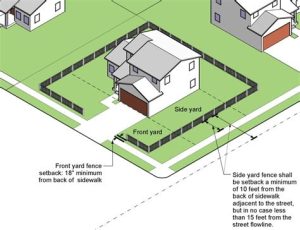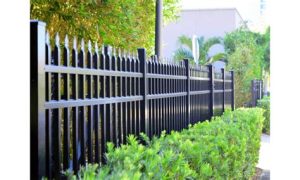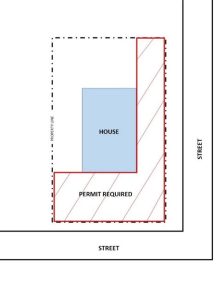Learn how to install a chain link fence with our step-by-step guide: assess the terrain, choose materials, prepare the ground, and more!Installing a chain link fence on uneven terrain can seem like a daunting task, but with the right approach and preparation, it can be manageable and even rewarding. A chain link fence offers security and visibility, making it a popular choice for residential and commercial properties alike. However, the challenges presented by slopes, dips, and irregular ground can complicate the installation process. This blog post will guide you through the essential steps to successfully install a chain link fence, whether you’re a DIY enthusiast or a homeowner seeking to enhance your property. From assessing the terrain to selecting suitable materials and preparing the ground, each step is crucial in ensuring a sturdy and attractive fence. So, roll up your sleeves and let’s dive into this comprehensive guide to transforming your uneven land into a beautifully fenced space!
Assessing the Terrain
When it comes to installing chain link fences on uneven ground, the first and arguably most critical step is assessing the terrain. Understanding the natural contours and variations of your land will directly influence the effectiveness and longevity of your fence.
Begin by walking the entire length of the proposed fence line. Make note of any hills, dips, or obstacles that could impede installation. It’s essential to have a clear picture of any changes in elevation. Use a level to check for the steepness of slopes and take measurements of different heights along the line.
It may also be helpful to create a simple sketch of your property, marking areas that need special attention during installation. Whether it’s a rocky outcrop, a low-lying wet patch, or dense vegetation, being aware of these features will allow you to plan accordingly, ensuring a smooth installation process.
Choosing the Right Materials
When it comes to installing chain link fences, selecting the right materials is crucial, especially if you’re working with uneven terrain. The right materials not only ensure durability but also enhance the overall aesthetic of the fence.
The primary material needed for a chain link fence installation includes the chain link fabric, posts, rails, and gates.
- Chain Link Fabric: Choose a fabric gauge that suits your needs. Thicker gauges offer better strength and security, but they can be more difficult to install.
- Posts: Opt for galvanized steel posts to prevent rusting. The size of the posts should correspond to the height of your fence. Typically, 1-5/8 inch posts work well for most residential fences.
- Top Rails: Not all environments require top rails, but they provide added stability that is beneficial on uneven terrain.
- Gates: Make sure that the gates match the height and strength of your chain link fabric for a cohesive look and added security.
In addition, consider the accessories required for installation, such as tension bands, tension wire, and privacy slats if you desire added privacy. Keeping these materials in mind will streamline your installation process and ensure a smooth workflow.
Preparing the Ground
Before you start the installation of a chain link fence on uneven terrain, it’s crucial to ensure that the ground is adequately prepared. This step not only impacts the overall stability of the fence but also the ease of installation. Here’s a step-by-step guide to help you through the process.
1. Clear the Area: Begin by removing any debris, rocks, or vegetation within the perimeter where the fence will be installed. This can involve using tools like shovels, rakes, and possibly even a wheelbarrow to transport heavier materials.
2. Level the Ground: On uneven ground, you will need to level or contour the soil. Use a leveling tool or a string line to identify high and low spots. Depending on the slope, you may want to fill in low areas with soil and compact it, or remove excess soil from high spots. Be cautious during this step to avoid creating a dip that could compromise the fence’s strength over time.
3. Mark the Fence Line: Once the ground is prepared, use stakes and string to mark the exact line of your fence. This line will serve as a guide during the installation process, ensuring that your chain link fabric follows the intended path. Ensure that the markings are straight, even on uneven terrain, to maintain an aesthetically pleasing look.
By following these preparation steps, you set a solid foundation for successfully installing a chain link fence on uneven ground. Proper groundwork can save you time and resources, allowing for a more efficient and durable installation.
Setting Up the Corner Posts
Setting up the corner posts is a crucial step when installing chain link fences on uneven terrain. These posts will serve as the foundational framework for your entire fence, ensuring stability and alignment throughout the installation process. Properly setting these posts will prevent any sagging or stretching of the chain link fabric, which can occur if the posts are not adequately secured.
Begin by determining the exact locations for your corner posts. Use a measuring tape to ensure that the distances between the posts are consistent with your design. Remember to account for any inclination or slopes in the terrain as they can affect the overall positioning of the fence. Mark these positions clearly using a stake or spray paint to avoid any confusion during installation.
Next, dig the holes for your corner posts. The depth of the hole should be about one-third of the post height, which provides enough stability. You may use a post hole digger or a power auger for this purpose. Once the holes are dug, insert the posts into their designated positions. To ensure they are plumb and level, it can be beneficial to use a level tool during this process. Fill the holes with concrete mix to secure the posts in place and allow it to cure for the recommended time according to the manufacturer’s instructions.
Installing the Chain Link Fabric
Once you have successfully set up the corner posts and ensured they are firmly anchored, it’s time to focus on installing the chain link fabric. This step is crucial as it determines the overall strength and durability of your fence.
- Unroll the Chain Link Fabric: Begin by unwinding the chain link fabric along the fence line. Ensure it is facing the correct way, with the top edge following the contour of the posts.
- Attach to Corner Posts: Start by attaching the fabric to the corner posts using the provided tie wires. Space the ties about 12 to 24 inches apart to ensure a secure attachment. You can use a wire cutter to trim any excess.
- Pull the Fabric Taut: Move along the fence line and gently pull the fabric taut towards the next post. This step is essential to prevent sagging.
- Secure the Fabric to Line Posts: As you reach each line post, use the tie wires to attach the fabric securely. Again, spacing is key, so maintain regular intervals for a consistent look and feel.
- Finish Off: Once you reach the end, cut the fabric to size, ensuring it is flush with the last line post. Secure it with tie wires as before.
Throughout this process, ensure consistency in tension to avoid any weak spots. An uneven installation can lead to issues down the line, so take your time to check the alignment and tension frequently.
After attaching the fabric, you may want to consider adding additional support, especially in uneven terrains. This may involve using tension bands at intervals to help keep the fabric straight and taut against the pressures of wind and weather.
Finally, once everything is installed, inspect the entire length of your chain link fence for any adjustments or loose areas that may need tightening. Proper installation at this stage will ensure a long-lasting and resilient fence.
Frequently Asked Questions
What materials do I need to install a chain link fence on uneven terrain?
You will need chain link fabric, fence posts, tension bands, top rails, post caps, concrete, and tools such as a post hole digger, level, and fence pliers.
How do I determine the layout for my chain link fence?
Start by marking the corners and gate locations with stakes, then use string or mason’s line to outline the desired fence line.
What is the best way to install fence posts on uneven ground?
Use a post hole digger to create holes and adjust the depth of each post according to the elevation of the terrain, ensuring posts are level vertically.
How can I ensure the chain link fabric hangs properly on an uneven terrain?
Install tension bands at the top of each post and attach the fabric at various heights to maintain a straight line, adjusting as needed for dips and rises.
What should I do if my terrain has steep slopes?
Consider using stepped installation where the fence follows the contour of the slope or opt for a racked installation which allows the fabric to angle with the grade.
How do I secure the bottom of the chain link fence on uneven ground?
Bury the bottom of the chain link fabric into the ground or use bottom tension wire to keep the bottom tight and prevent gaps.
Are there any tips for maintaining the fence after installation?
Regularly check the tension of the fabric, inspect for any rust or damage on the posts and fittings, and clear vegetation from around the base.





